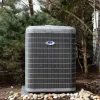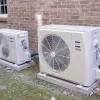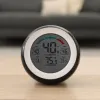If you’re asking what type of freon your home AC uses, there’s a good chance you’re dealing with an HVAC problem. Maybe you called a contractor to repair the system and they told you there was a leak. Or maybe you’re just curious about the different kinds of refrigerant that are available.
In any case, most air conditioners in the United States only use just one of two different kinds of refrigerants. If your AC was designed for one of those types, then it’s the only one you should use for that system.
Let’s take a quick look at the most common types of refrigerant in use in residential air conditioning systems.
R-410A: the most common type of refrigerant
If your air conditioning system or heat pump was installed after 2010, it almost definitely uses R-410A refrigerant. Many ACs installed before that year also used R-410A.
R-410A is the most common type of refrigerant currently being used in air conditioning systems. It’s what’s in all of the central systems we install in homes around the Atlanta area. In addition, it’s readily available and easy for us to purchase. If you need it, we can get it. In fact, we already have lots of it!
Note that R-410A refrigerant is not Freon. Many people still call it Freon, but that’s a misnomer. Freon was the trade name for R-22 refrigerant, which is no longer used in new AC installations.
If you have a refrigerant leak in an out-of-warranty system and need to top it off before installing a new system, you can expect a contractor to show up with a tank of R-410A. To be sure, topping off a leaking system with R-410A is not a long term solution! A refrigerant leak is a major HVAC problem. You will either need to replace the evaporator coil (this is probably where the leak is) or replace the system itself.
In the event you’re wondering whether your contractor can reuse a copper line set that was previously used with a different type of refrigerant (R-22, probably), the answer is yes! But there are caveats:
- The line set has to be the right diameter; check the manufacturer’s specifications about this.
- Your HVAC contractor needs to perform a triple evacuation on the line set to remove all traces of old refrigerant and oils.
R-410A is very much today’s refrigerant. It will eventually be phased out in favor of other types (more on this in a bit), but it’s not going anywhere for a long time.
R-22, aka Freon: a common, but obsolete refrigerant
Freon was the marketable trade moniker for R-22 refrigerant. This type of refrigerant was first developed in the 1920s and became the most common type of refrigerant used in air conditioning systems for many decades. If your AC or heat pump was installed before 2010, there’s a good chance it used R-22 refrigerant.
Unfortunately, Freon had a dark side. As a hydrochlorofluorocarbon (HCFC), R-22 was a major contributor to ozone depletion. The EPA mandated a phase-out starting in 2010. After that year, no new air conditioning systems were permitted to use R-22 refrigerant. As of 2020, it is no longer legal to sell or manufacture new R-22 refrigerant. For this reason, supply is scarce and Freon (the real kind) is very expensive.
The thing is, well-built and maintained air conditioning systems have a tendency to hang on. Many homeowners still use ACs that rely on R-22 because, well, those old systems still work! But when they develop a leak, the homeowner is suddenly put in a bind.
They can try and source R-22, pay an incredible amount of money for it, and top off the system for some period of time. Or they can just purchase a new system, which is the smarter and better option for so many reasons.
You may have heard of drop-in refrigerants that can be used in place of R-22. You can use these, but you will experience diminished system performance. Your power bills will be higher and the system might not cool as well as it used to. Also, you’ll still have a refrigerant leak, which you will have to keep topping off… forever. We think this is a bad idea.
At the time of writing, we still have a very small amount of R-22 refrigerant on hand from the before times. After it’s gone, that’s it. We won’t have it anymore.
Next generation refrigerants: R-32 and R-454B
Although ozone depletion is no longer a concern when it comes to modern refrigerants, the EPA is concerned about different refrigerants’ global warming potential, or GWP. R-410A may be a more environmentally friendly product than the R-22 it replaced. However, it’s not the most energy efficient type on the market today and the EPA has already proposed a phaseout of new R-410A systems starting in 2025.
But wait! Didn’t we just say that R-410A was “today’s refrigerant?” How is that the case if it’s being phased out?
R-410A is going to be around for a long time. If you’re buying a new AC today and it uses R-410A refrigerant, don’t worry. The proposed phaseout is gradual and HVAC contractors will have plenty of R-410A on hand for years to come. With precious few exceptions, all current central AC units being sold today use R-410A refrigerant.
However, the impending phaseout being what it is, many manufacturers are already using newer refrigerants in their air conditioning systems. Daiken, for example, uses R-32 refrigerant in some of its equipment. The company claims R-32 is the “most balanced” refrigerant, that it conveys heat more efficiently than R-410A, and has a lower GWP. Lennox is also on board with R-32.
Carrier, on the other hand, plans to use R-454B refrigerant in some new systems. R-454B also has lower GWP than R-410A and meets the EPA’s latest guidelines.
There are other low-GWP refrigerants out there and different manufacturers will be turning to different ones in the years to come. Until now, every HVAC equipment maker has basically used the same type of refrigerant, but it looks like we’re entering a new era in which different companies use different types. We’ll know for sure in a few more years.
Got a refrigerant question? We can help!
If you live in Metro Atlanta and are concerned about the type of refrigerant your air conditioning system uses, give us a call at (404) 994-2229. We can visit your home and troubleshoot any AC problem to find the best solution!






